Choices in Choicemaking
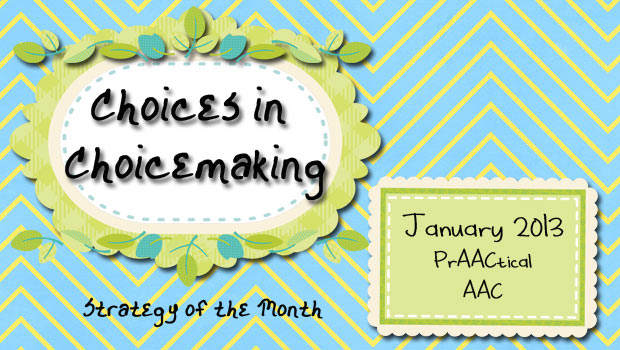
Choicemaking and requesting may be the most frequently targeted areas for beginning communicators who are starting out with their AAC systems. That makes sense for some learners because making choices is a very concrete focus for interaction and is loaded with motivational power. It seems pretty straightforward but, like anything else we do clinically, there are lots of decisions and choices to be made as we delve deeper into the process.
- How can we craft an AAC system that targets requesting for now, but also supports core language learning? For communicators who are at the earliest stages of making requests with AAC symbols, the strategy we discussed earlier this month or simple choice boards are a good starting point. But unless we quickly address where this is all going, the client will be strictly limited in their language learning. There are many ways to do this. Here is one approach.
- To avoid limiting the client’s language learning, we have to figure out what their early AAC system will look like and how core vocabulary will be addressed. If you’re not sure where to start, we recommend beginning with some communication
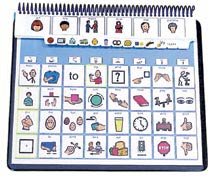 boards that have room for at least 50 symbols for core words, such as pronouns, common verbs, descriptors, and locatives. We can use this along with a choicemaking board that has preferred and non-preferred items
boards that have room for at least 50 symbols for core words, such as pronouns, common verbs, descriptors, and locatives. We can use this along with a choicemaking board that has preferred and non-preferred items - Then, think about how many your learner can handle at this stage, with the understanding that these are words that YOU will be using to talk to them (not the reverse) using aided language input. We usually start with 8-12.
- Look at your core word board with 50+ symbols, and decide which 8-12 are the best to start with. Again, these are words that WE are using when we talk to the learner. These are NOT words we are eliciting from the learner, for the most part, at this stage.
- Make a version of the core word board that covers up all but the 8-12 words you’ve decided to start with. We usually use gray boxes to hide the remaining 38-42 symbols, so that the beginning communicator learns to ignore the gray boxes and focuses on the symbols.
- Use the core word boards before and after the learner makes requests to narrate the actions and make conversation. Present the choicemaking board when eliciting requests, and then go back to the core word board to ‘speak AAC’ to the learner.
- “So, am I going back and forth between two boards?” Yes. One tip: make them the same size and don’t laminate them. Instead insert them back-to-back into a page protector so that you can just flip it over to go from requesting to core language. Of course, there are other approaches, too. We’re not saying this is the best for everyone, but we wanted to give a concrete idea of how to do this for those who just aren’t sure how to proceed.
- Over time, make additional versions of the core word board that reveal more and more of the 50+ words on the original board. Replace the old boards with the slightly expanded versions as you and the learner acclimate to the vocabulary.
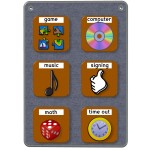
- To avoid limiting the client’s language learning, we have to figure out what their early AAC system will look like and how core vocabulary will be addressed. If you’re not sure where to start, we recommend beginning with some communication
- “How can I get the AAC learner to make requests throughout the day?” Consider writing some safeguards into the goal. I like using phrases like these: “across activities/environments” “in at least 3 activities/day” “at least twice per activity”
- “My client isn’t very motivated by ‘things’ other than food. How else can I build requesting skills?” Here are some things to try that go beyond choosing objects:
- A partner to work with (e.g., “Do you want to play with Jenna or Marcus?”)
- Someone to sit beside (e.g., “You can sit by me or Alyssa.”)
- Who will help the learner (e.g., “Who do you want to help you? Ms. Margie or Marcus?”)
- What to do next (e.g., “What do you want to do now? Math Center or Listening Center?”)
- Where to put ___ (e.g., “You can put it on the table or in my bag.”)
- Someone to give ___ to (e.g., “Do you want to give it to me or Ms. Margie?”)
- Where to go next (e.g., “Should we do it at the table or on the floor?”)
- How to travel around the environment (e.g. “Should we hop or dance?”)
- How to move something (e.g., “Should the plane fly up or down?”
Teaching someone to choose something they want or the way they want to do something is a great way to build personal autonomy, highlight the real power of communication, and give frequent opportunities for prAACtice. We’d love to hear some of the fun ways that you’re doing this in your own practice.
Filed under: Strategy of the Month
Tagged With: beginning communicator, choice, choicemaking, core vocabulary, requesting
This post was written by Carole Zangari


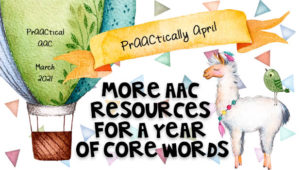
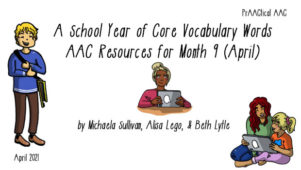

3 Comments
Great Post Carole, although I find the hardest thing to do is to figure out WHAT core words will make sense to my son. I have stuck to requesting choice boards that are ‘similar’ in nature but not exactly the same. The top few boxes are I WANT, MORE, FINISHED, and the next row is all requesting options. The third row is ‘something else’, ‘I like’, ‘I don’t like’ etc. But I find the more I add to the boards the more visually confusing it appears to be for him. He doesn’t have the best of vision and won’t tolerate his glasses on full time. To have 50+ boxes on a board would be just TOO much, greyed out or not. So we have basically a ‘menu’ of food items and I just continually change the choice boards over dependant on the time of the day. We have since got a TV choice board, and a Bedtime choice board with book selections, and DVD choices etc. But I have had a difficult time teaching him anything other than nouns and cannot fathom how to incorporate ‘core’ words into his vocabulary or make AAC motivating for him (he has an AAC app on his iPad but isn’t motivated to use it).
Vivien, you are not alone in trying to make the general case scenario work for an individual child. Here are some thoughts. First, our ‘go-to’ strategy is aided language input. If we uses the AAC tools all day long when we are talking to the learners, it helps to establish a solid foundation. I always figure that the kids will do about 5% of what they see me do, so if I want them to do more, then I try to do more. Also, we often separate out the core vocabulary (pronouns, verbs, etc) from the activity-specific vocabulary (particularly the nouns). For beginning communicators, we generally don’t focus on having them combine words to make sentences (e.g., I want more, finished puzzles). Hope that helps a little. Thanks for taking the time to comment, Vivien!
This is great! Do you advise copying that core word example on to one AAC device (such as Go Talk now) or……